Richmond Park

Richmond Park is a royal park in Surrey, extending over 2,360 acres, or 3.69 square miles. It is found to the south-east of Richmond and north-west of Kingston upon Thames, a vast expanse of green parkland otherwise surrounded by the urban growth of the metropolis.
The park was created by King Charles I in the 17th century[1] as a deer park, and deer remain roaming free in the park. It is today regarded as of national and international importance for wildlife conservation. The park is a national nature reserve, a Site of Special Scientific Interest and a Special Area of Conservation and is included, at Grade I, on the Register of Historic Parks and Gardens. Its landscapes have inspired many famous artists and it has been a location for several films and television series.
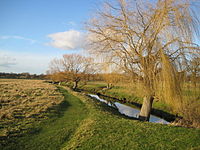
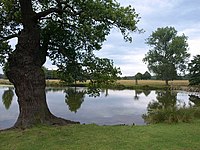

Richmond Park includes many buildings of architectural or historic interest. The Grade I-listed White Lodge was formerly a royal residence and is now home to the Royal Ballet School. The park's boundary walls and ten other buildings are listed at Grade II, including Pembroke Lodge, the home of 19th-century British Prime Minister Lord John Russell and his grandson, the philosopher Bertrand Russell.
Historically the preserve of the monarch, the park is now open for all to use and includes a golf course and other facilities for sport and recreation.
Management and access
The Secretary of State for Culture, Media and Sport manages Richmond Park and the other Royal Parks of under powers set out in the Crown Lands Act 1851, which transferred management of the parks from the monarch to the government. Day-to-day management of the Royal Parks has been delegated to The Royal Parks, an executive agency of the Department for Culture, Media and Sport (DCMS). The Royal Parks' Board sets the strategic direction for the agency.
Richmond Park is enclosed by a high wall with several gates, which either allow pedestrian and bicycle access only, or allow bicycle, pedestrian and other vehicle access. The gates for motor vehicle access are open only during daylight hours, and the speed limit is 20 mph. Apart from taxis, no commercial vehicles are allowed unless they are being used to transact business with residents of the park.[2]
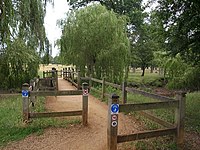
The gates open to motor traffic are: Sheen Gate, Richmond Gate, Ham Gate, Kingston Gate, Roehampton Gate and (for access to Richmond Park Golf Course only) Chohole Gate.[3][4] There is pedestrian and bicycle access to the park 24 hours a day except during the Culling#Wildlife|deer cull in February and November when the pedestrian gates are closed between 8:00 pm and 7:30 am.[5]
The Beverley Brook Walk runs through the park between Roehampton Gate and Robin Hood Gate. The Capital Ring walking route passes through the park from Robin Hood Gate to Petersham Gate. The Thames Cycle Route runs across the park from Ham Gate to Roehampton Gate. London Cycle Network route no. 3 goes through the park.
The park has designated bridleways and cycle paths. These are shown on maps[3] and noticeboards displayed near the main entrances, along with other regulations that govern use of the park. The bridleways are special in that they are for horses (and their riders) only and not open to other users like normal bridleways. Cycling is allowed only on main roads and on the Tamsin Trail (the shared-use pedestrian cycle path that runs close to the park's perimeter).[6]
As the park is a national nature reserve and a Site of Special Scientific Interest, all dog owners are required to keep their dogs under control while in the park. This includes not allowing their dog to disturb other park users or disrupt wildlife. In 2009, after some incidents leading to the death of wildfowl, the park's dogs on leads policy was extended. Park users are said to believe that the deer are feeling increasingly threatened by the growing number of dogs using the park and Royal Parks advises against walking dogs in the park during the deer's birthing season.
Sport and recreation
- Cycling: Bicycles can be hired near Roehampton Gate and, at peak times, near Pembroke Lodge. The Tamsin Trail (shared between pedestrians and cyclists) provides a circuit of the park and is almost entirely car-free.[7]
- Fishing: On Pen Ponds by paid permit in season.
- Golf is played at Richmond Park Golf Course
- Horse riding: A popular activity in the park, serviced by several local stables.
- Rugby: Three pitches are laid out in the grassland to the north of the Roehampton Gate (Rosslyn Park RFC).
- Running: The Tamsin Trail is a seven-mile trail around the park which is popular with runners.
There are children's playgrounds at Kingston Gate and Petersham Gate.
Friends of Richmond Park
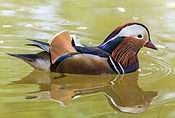
The Friends of Richmond Park was founded in 1961 to protect the park. In 1960 the speed limit in the park had been raised from 20 to 30 miles an hour and there were concerns that the roads in the park would be assigned to the main highway system as had recently happened in parts of Hyde Park.[8] In 1969, plans to assign the park's roads to the national highway were revealed by the Friends and subsequently withdrawn.[9] The speed limit was reduced to 20 miles an hour in the summer of 2004.[10]
In 2011, the Friends successfully campaigned for the withdrawal of plans for open air screenings of films in the park.[11][12] In 2012, the Friends contributed towards the cost of a new Jubilee Pond, and launched a public appeal for a Ponds and Streams Conservation Programme in which the Friends, the Richmond Park Wildlife Group and Healthy Planet have been working with staff from The Royal Parks to restore some of the streams and ponds in the park.[13][14][15]
The Friends run a visitor centre near Pembroke Lodge, organise a programme of walks[16] and education activities for young people, and produce a quarterly newsletter. The Friends have published two books, A Guide to Richmond Park and Family Trails in Richmond Park; profits from the books' sales contribute towards the Friends' conservation work.[17][18]
The Friends of Richmond Park has been a charitable organisation since 2009. The Friends Forum enables the chairmen of all the Royal Parks Friends groups to meet regularly to discuss common issues and to make their views known to the chief executive of the Royal Parks, the Royal Parks Advisory Group and the Department of Culture, Media and Sport.[19]
History
In 1625 King Charles I brought his court to Richmond Palace to escape an outbreak of plague in London[20] and turned the area on the hill above Richmond into a park for the hunting of red and fallow deer.[20][21] It was originally referred to as the king's "New Park"[22] to distinguish it from the existing park in Richmond, which is now known as Old Deer Park. In 1637 he appointed Jerome Weston, 2nd Earl of Portland as keeper of the new park, for life, with a fee of 12 pence a day, pasture for four horses, and the use of the brushwood.[23] Charles's decision, also in 1637, to enclose the land[nb 1] was not popular with the local residents, but he did allow pedestrians the right of way.[24] To this day the walls remain, although they have been partially rebuilt and reinforced.
Following Charles I's execution, custodianship of the park passed to the Corporation of the City of London. It was returned to the restored monarch, King Charles II, on his return to London in 1660.[25]
In 1736 the Queen's Ride was cut through existing woodland to create a grand avenue through the park.[26]
Public access
In 1751, Princess Amelia became ranger of Richmond Park after the death of Robert Walpole. Immediately afterwards, the Princess caused major public uproar by closing the park to the public, only allowing few close friends and those with special permits to enter.[27] This continued until 1758, when a local brewer, John Lewis, took the gatekeeper, who stopped him from entering the park, to court.[28] The court ruled in favour of Lewis, citing the fact that, when Charles I enclosed the park in the 17th century, he allowed the public right of way in the park. Princess Amelia was forced to lift the restrictions.[29][30]
Full right of public access to the park was confirmed by Act of Parliament in 1872.[31] However, people were no longer given the right to remove firewood; this is still the case and helps in preserving the park.[20]
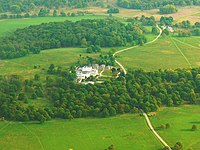
King Edward VII developed the park as a public amenity by opening up almost all the previously fenced woods and making public those gates that were previously private.[32] From 1915 level areas of the park were marked out for football and cricket pitches.[32] A golf course was developed on the former "Great Paddock" of Richmond Park, an area used for feeding deer for the royal hunt. The tree belt in this part of the park was supplemented by additional planting in 1936.[33] The golf course was opened in 1923 by Edward, Prince of Wales[34] (who was to become King Edward VIII and, after his abdication, Duke of Windsor). The future king had been born in the park, at White Lodge, in 1894.[35]
Improvements
Pen Ponds, a lake divided in two by a causeway, was dug in 1746 and is now a good place to see water birds.[20] John Rocque's Map of London, 1746 shows Pen Ponds for the first time, named as The Canals.[36] Between 1855 and 1861, new drainage improvements were constructed, including drinking points for deer.[37]
Between 1833 and 1842 the Petersham Lodge estate, and then part of Sudbrook Park, were incorporated into Richmond Park. Terrace Walk was created from Richmond Gate to Pembroke Lodge.[38]
Wartime use
In or around 1870, the Inns of Court Rifle Volunteers were using an area near Bog Gate as a drill ground.[37]
During the First World War cavalry trained in the park. On 7 December 1915 the inventor Harry Grindell Matthews demonstrated, in a secret test on Pen Ponds, how selenium cells would work in a remotely controlled prototype weapon for use against German Zeppelins,[39] though the invention was not in the event deployed. Between 1916 and 1925 the park housed a South African military war hospital, demolished in 1925.
During Second World War Pembroke Lodge was used as the base for "Phantom" (the GHQ Liaison Regiment). The Pen Ponds were drained, in order to disguise them as a landmark,[40] and an experimental bomb disposal centre was set up at Killcat Corner, which is between Robin Hood Gate and Roehampton Gate.[41]
In the park
Gates
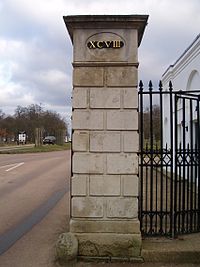
When the park was enclosed in 1637 there were six gates in the boundary wall: Coombe Gate, Ham Gate, Richmond Gate, Robin Hood Gate, Roehampton Gate and Sheen Gate, of which Richmond Gate has the heaviest traffic. The present gates were designed by Sir John Soane[42][43]
Sheen Gate was where the brewer John Lewis asserted pedestrian right of entry in 1755 after Princess Amelia had denied it, but the present double gates date from 1926.[44] Coombe Gate (later known as Ladderstile Gate) provided access to the park for the parishioners of Coombe, with both a gate and a step ladder. The gate was locked in the early 1700s and bricked up in about 1735. The stepladder was reinstated after John Lewis's case in 1758 and remained in place until about 1884. The present gate dates from 1901.[44] The present wrought iron gates of Roehampton Gate were installed in 1899.[44]
Robin Hood Gate takes its name from the nearby Robin Hood Inn (demolished in 2001) and is close to what is called[45] the Robin Hood roundabout on the A3.
Chohole Gate served the farm that stood within the park on the site of the present Kings Farm Plantation. It is first mentioned in 1680.[44] The gate now provides access to Richmond Park Golf Course. Kingston Gate dates from about 1750. The existing gates date from 1898.[44]
Buildings
The Park includes a Grade I listed building, White Lodge. The boundary wall of the park is Grade II listed as are ten other buildings: Ham Gate Lodge, built in 1742;[46] Holly Lodge (formerly known as Bog Lodge) and the game larder in its courtyard, built in 1735; Pembroke Lodge; Richmond Gate and Richmond Gate Lodge, dated 1798 and designed by Sir John Soane;[47][48][49] Thatched House Lodge; and White Ash Lodge and its barns and stables, built in the 1730s or 1740s.[50][51]
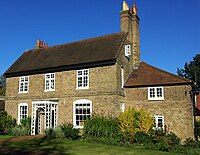
Holly Lodge also includes the Holly Lodge Centre, an educational centre focusing on the environment and the Victorian history and heritage of Richmond Park.

Pembroke Lodge and some associated houses stand in their own garden within the park. In 1847 Pembroke Lodge became the home of the then Prime Minister, Lord John Russell and was later the childhood home of his grandson, Bertrand Russell. It is now a popular restaurant with views across the Thames Valley.
Thatched House Lodge was the London home of U.S. General Dwight D. Eisenhower during the Second World War. Since 1963 it has been the residence of Princess Alexandra, The Honourable Lady Ogilvy. The gardens include an 18th-century two-room thatched summer house which gave the main house its name.
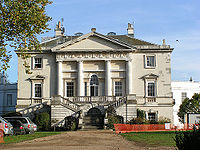
The White Lodge was built as a hunting lodge for King George II and completed in 1730. Its many famous residents have included members of the Royal Family. The future Edward VIII was born at White Lodge in 1894.[52] In the 1920s it provided a home for the Duke and Duchess of York (the future King George VI and Queen Elizabeth).
King Henry's Mound
King Henry's Mound, a Neolithic burial barrow,[53] is the highest point within the park and is located within the public gardens of Pembroke Lodge. At various times the mound's name has been connected with Henry VIII or with his father Henry VII.[53] But there is no evidence to support the legend that Henry VIII stood on the mound to watch for a sign from St Paul's that Anne Boleyn had been executed at the Tower and that he was then free to marry Jane Seymour.[53]
To the west of King Henry's Mound is a panorama of the Thames Valley. St Paul's Cathedral, over 10 miles to the east, can be seen through the naked eye or through a telescope that has been installed on the Mound. This vista is protected by a "dome and a half" width of sky on either side.
Nature
Wildlife
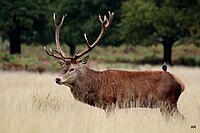

Originally created for deer hunting, Richmond Park now has 630 red and fallow deer[54] that roam freely within much of the park. A cull takes place each November and February to ensure numbers can be sustained.[55] Some deer are also killed in road accidents, through ingesting litter such as small items of plastic, or by dogs; three deer were killed by dogs in 2012.[54] Many of the deer in Richmond Park are infected with a bacterium called Borrelia burgdorferi which can be transmitted to humans through a tick bite causing Lyme disease.[56]
The park is an important refuge for other wildlife, including woodpeckers, squirrels, rabbits, snakes, frogs, toads, stag beetles and many other insects plus numerous ancient trees and varieties of fungi. It is particularly notable for its rare beetles.
Richmond Park supports a large population of what are believed to be Ring-necked (or Rose-ringed) Parakeets. These bred from birds that escaped or were freed from captivity.[57]
Ponds and streams
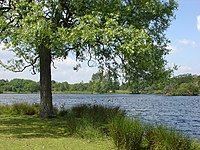

There are about 30 ponds in the park. Some – including Barn Wood Pond, Bishop's Pond, Gallows Pond, Leg of Mutton Pond, Martin's Pond and White Ash Pond – have been created to drain the land or to provide water for livestock. The Pen Ponds (which in the past were used to rear carp for food)[58] date from 1746.[20] They were formed when a trench was dug in the early 17th century to drain a boggy area; later in that century this was widened and deepened by the extraction of gravel for local building. The Ponds now take in water from streams flowing from the higher ground around them and release it to Beverley Brook. Beverley Brook and the two Pen Ponds are most visible areas of water in the park.[59]
Beverley Brook rises at Cuddington Recreation Park in Worcester Park[60] and enters the park (where it is followed by the Tamsin Trail and Beverley Walk) at Robin Hood Gate, creating a water feature used by deer, smaller animals and water grasses and some water lilies. Its name is derived from the former presence in the river of the beaver (Castor fiber),[61] a species extinct in Britain since the sixteenth century.[62]
Most of the streams in the park drain into Beverley Brook but a spring above Dann's Pond flows to join Sudbrook on the park boundary. Sudbrook flows through a small valley known as Ham Dip and has been dammed and enlarged in two places to form Ham Dip Pond and Ham Gate Pond, first mapped in 1861 and 1754 respectively. These were created for the watering of deer.[63] Both ponds underwent restoration work including de-silting, which was completed in 2013.[64] Sudbrook drains the western escarpment of the hill that, to the east, forms part of the catchment of Beverley Brook and, to the south, the Hogsmill River. Sudbrook is joined by the Latchmere Stream just beyond Ham Gate Pond. Sudbrook then flows into Sudbrook Park, Petersham. Another stream rises north of Sidmouth Wood and goes through Conduit Wood towards the park boundary near Bog Gate.[59]
A separate water system for Isabella Plantation was developed in the 1950s. Water from the upper Pen Pond is pumped to Still Pond, Thomson's Pond and Peg's Pond.[59]
The park's newest pond is Attenborough Pond, opened by and named after the broadcaster and naturalist Sir David Attenborough in July 2014.[65] It was created as part of the park's Ponds and Streams Conservation Programme.[66]
In culture
Literature
Amongst many appearances of the park in books:
- The Marquis of Lossie, a novel by George MacDonald (1877) has a chapter "Richmond Park".[67]
- Sylvester, or the Wicked Uncle, a Regency romance by Georgette Heyer (1957) has an expedition to Richmond Park.[68]
- The Other Hand (Chris Cleave, 2008) has a picnic scene in the Isabella Plantation
- Lily Alone by Jacqueline Wilson (2010) and also in the poetry anthology she edited, Green Glass Beads (2011).[69]
- Moriarty, a novel by Anthony Horowitz (2014) a continuation Sherlock Holmes story, includes a scene set in Richmond Park.
On film
Richmond Park has been a location for several films and TV series:
- A locomotive runs through the park and crashes into a tree in the film The Titfield Thunderbolt (1955).
- Anne of the Thousand Days (1969);[70] the story of King Henry VIII's courtship of Anne Boleyn and their marriage.
- An Indian dust storm was filmed in the park for the film Heat and Dust (1983).
- Billy Elliot (2000) features The Royal Ballet School in Richmond Park
- Sherlock Holmes 2 (2011) had scenes filomed in the park.
- Into the Woods (2014), a Disney fantasy film
Outside links
| ("Wikimedia Commons" has material about Richmond Park) |
- Royal Parks
- Richmond Park map (PDF)
- Royal Parks' visitor information on Richmond Park
- Friends of Richmond Park
- The Heritage Pavilion (video, 2014), The Hearsum Collection
References
- ↑ National Monuments Record: No. 397979 – Richmond Park
- ↑ The Royal Parks and Other Open Spaces Regulations 1997
- ↑ 3.0 3.1 "Richmond Park map". The Royal Parks. https://www.royalparks.org.uk/__data/assets/pdf_file/0017/41642/richmondpark_english_map.pdf. Retrieved 1 February 2015.
- ↑ "Getting to the Park". Richmond Park Management Plan. The Royal Parks. January 2008. p. 10. https://www.royalparks.org.uk/__data/assets/pdf_file/0007/41767/richmond-park-management-plan.pdf. Retrieved 2 February 2015.
- ↑ "Opening times and getting here". Visitor information. The Royal Parks. https://www.royalparks.org.uk/parks/richmond-park/visitor-information/opening-times-and-getting-here. Retrieved 1 February 2015.
- ↑ "Cycling in the Royal Parks". Park Regulations and Policies. The Royal Parks. https://www.royalparks.org.uk/parks/richmond-park/visitor-information/park-regulations-and-policies/cycling-in-the-royal-parks. Retrieved 1 February 2015.
- ↑ "Tamsin Trail, Richmond Park". Sustrans. http://www.sustrans.org.uk/ncn/map/route/tamsin-trail-richmond-park. Retrieved 31 December 2013.
- ↑ Pollard and Crompton, pp. 2–3
- ↑ Pollard and Crompton, p. 9
- ↑ Pollard and Crompton, p. 33
- ↑ Paul Teed (11 August 2011). "Richmond Park cinema plans withdrawn". Richmond Guardian. http://www.yourlocalguardian.co.uk/news/local/richmondnews/9190284.Richmond_Park_cinema_plans_withdrawn/. Retrieved 9 April 2012.
- ↑ "Friends oppose Park screenings". Friends of Richmond Park website. 19 July 2011. http://www.frp.org.uk/news/158-friends-oppose-park-screenings. Retrieved 28 June 2012.
- ↑ "New Jubilee Pond in Richmond Park to be Created". St Margarets Community website. 11 May 2012. http://www.stmgrts.org.uk/archives/2012/05/new_jubilee_pond_in_richmond_park_to_be_created.html. Retrieved 5 June 2012.
- ↑ Christine Fleming (10 May 2012). "Jubilee pond to open in Richmond Park". Richmond Guardian. http://www.yourlocalguardian.co.uk/news/local/richmondnews/9699149.Jubilee_pond_to_open_in_Richmond_Park/. Retrieved 5 June 2012.
- ↑ "Work starts on more ponds". Friends of Richmond Park. 2012. http://www.frp.org.uk/news/225-work-starts-on-more-ponds. Retrieved 6 October 2012.
- ↑ "Walking Works Campaign". University of Roehampton. 2012. http://www.roehampton.ac.uk/Campus/Environment/Projects-and-Initiatives/Walking-Works/. Retrieved 7 February 2015.
- ↑ "New guide book to Richmond Park". London Borough of Wandsworth. 28 March 2011. http://www.wandsworth.gov.uk/news/article/10356/new_guide_book_to_richmond_park. Retrieved 4 April 2012.
- ↑ June Sampson (2 September 2011). "Trails give us thrill of discovery". Surrey Comet. http://www.frp.org.uk/pdf/news/170_SurreyComet_review_Sept_2011.pdf. Retrieved 4 April 2012.
- ↑ "The Friends of the Royal Parks Forum ("Friends Forum")". Friends of Greenwich Park. http://www.friendsofgreenwichpark.org.uk/index.php?page_id=38. Retrieved 23 October 2012.
- ↑ 20.0 20.1 20.2 20.3 20.4 "Richmond Park: Landscape History". The Royal Parks. https://www.royalparks.org.uk/parks/richmond-park/about-richmond-park/landscape-history. Retrieved 7 October 2012. Cite error: Invalid
<ref>tag; name "Landscape History" defined multiple times with different content - ↑ "About Richmond Park". The Friends of Richmond Park. http://www.frp.org.uk/richmond-park. Retrieved 5 June 2012.
- ↑ ref MPE 1/426. The National Archives (UK).
- ↑ William Douglas Hamilton (editor) (1888). Calendar of State Papers, Domestic series, of the reign of Charles I, 1644, preserved in Her Majesty's Public Record Office. London: HMSO. p. 234. http://archive.org/stream/cu31924091770309#page/n289/mode/2up.
- ↑ A History of the County of Surrey: Volume 3 - Victoria County History
- ↑ McDowall, p. 51
- ↑ Michael Davison (2011). "Buildings" in Guide to Richmond Park. Friends of Richmond Park. p. 97. ISBN 978-0-9567469-0-0.
- ↑ Kenneth J. Panton (2011). Historical Dictionary of the British Monarchy. Scarecrow Press, Inc. ISBN 0-8108-5779-0. p. 45
- ↑ Pollard and Crompton, p. 38
- ↑ "A Park Milestone Celebrated". Friends of Richmond Park. 2008. http://www.frp.org.uk/news/59-a-park-milestone-celebrated. Retrieved 6 February 2015.
- ↑ Max Lankester, Friends of Richmond Park (September 2009). "John Lewis' re-establishment of pedestrian access to Richmond Park". London Borough of Richmond upon Thames. http://www.richmond.gov.uk/john_lewis_brief_open.pdf. Retrieved 15 August 2012.
- ↑ Max Lankester (2011). "History" in Guide to Richmond Park. Friends of Richmond Park. p. 88. ISBN 978-0-9567469-0-0.
- ↑ 32.0 32.1 McDowall, p. 90
- ↑ McDowall, pp. 121–126
- ↑ Baxter Brown, p. 150
- ↑ Pamela Fletcher Jones (1972). Richmond Park: Portrait of a Royal Playground. Phillimore & Co Ltd. p. 36. ISBN 0850334977.
- ↑ Baxter Brown, p. 51
- ↑ 37.0 37.1 Cloake, p. 196
- ↑ Cloake, p. 190
- ↑ Jonathan Foster (2008). "Remote Controlled Boat". The Death Ray: The Secret Life of Harry Grindell Matthews. Jonathan Foster. http://www.harrygrindellmatthews.com/earlywireless.asp. Retrieved 6 February 2015.
- ↑ McDowall, p. 91
- ↑ Mike Osborne (2012). Defending London: A Military History from Conquest to Cold War. Stroud, Gloucestershire: The History Press. ISBN 978 07524 7930 9.
- ↑ "Gate design credited to Soane". News. Friends of Richmond Park. http://www.frp.org.uk/news/131-gate-design-credited-to-soane. Retrieved 12 September 2014.
- ↑ National Heritage List 1263361: Richmond Gate Lodge, Screen Walls, Gate Piers and Gates
- ↑ 44.0 44.1 44.2 44.3 44.4 McDowall, pp. 71–78
- ↑ Nigel Cox. "A3 Robin Hood Roundabout". Geograph. http://www.geograph.org.uk/photo/675837. Retrieved 8 October 2012.
- ↑ Cloake, p. 108
- ↑ Pollard and Crompton, p. 42
- ↑ "Gate design credited to Soane". Friends of Richmond Park. http://www.frp.org.uk/news/131-gate-design-credited-to-soane. Retrieved 17 July 2013.
- ↑ Richmond Gate Lodge, Screen Walls, Gate Piers and Gates - British Listed Buildings
- ↑ Michael Davison (2011). "Buildings" in Guide to Richmond Park. Friends of Richmond Park. p. 100. ISBN 095278470X.
- ↑ "White Ash Lodge, Richmond upon Thames". British Listed Buildings. http://www.britishlistedbuildings.co.uk/en-432480-white-ash-lodge-greater-london-authority. Retrieved 24 March 2013.
- ↑ Parishes: Richmond (anciently Sheen) – A History of the County of Surrey - Volume : {{{2}}} (Victoria County History)
- ↑ 53.0 53.1 53.2 Cloake, John (2014). "'Sheene Chase' and 'King Henry VIII's Mound': two incorrect myths concerning Richmond Park". Richmond History: The Journal of Richmond History Society 35: 38-40.
- ↑ 54.0 54.1 "Deer in Richmond Park". The Royal Parks. https://www.royalparks.org.uk/parks/richmond-park/richmond-park-attractions/wildlife/deer-in-richmond-park. Retrieved 7 February 2015.
- ↑ Rachel Bishop (5 November 2012). "Richmond Park deer cull begins". Wandsworth Guardian (London). http://www.yourlocalguardian.co.uk/news/local/wandsworthnews/10026864.Richmond_Park_deer_cull_begins/. Retrieved 9 November 2012.
- ↑ Paul Brown (24 November 2013). "Specieswatch: Ixodes ricinus (tick)". The Guardian. http://www.theguardian.com/environment/2013/nov/24/specieswatch-tick-lyme-disease. Retrieved 2 February 2015.
- ↑ Michael McCarthy (20 December 2010). "Parakeets cause problems for British wildlife". The Independent. http://www.independent.co.uk/environment/nature/parakeets-cause-problems-for-british-wildlife-2165449.html. Retrieved 3 February 2015.
- ↑ Nigel Reeve (2011). "Ecology" in Guide to Richmond Park. Friends of Richmond Park. p. 16. ISBN 978-0-9567469-0-0.
- ↑ 59.0 59.1 59.2 Michael Davison. "Water in the Park". Friends of Richmond Park. http://www.frp.org.uk/pdf/frp/401_Water_in_the_Park_.pdf. Retrieved 7 February 2015.
- ↑ Stephen Inwood (2008). Historic London: An Explorer's Companion. Pan Macmillan. p. 382. ISBN 0-230-70598-7.
- ↑ John Field (1980). Place-names of Greater London. Batsford. pp. 30,166. ISBN 0-7134-2538-5.
- ↑ Horace T. Martin (1892). Castorologia: Or The History and Traditions of the Canadian Beaver. W. Drysdale. p. 26. ISBN 0-665-07939-7. http://books.google.com/books?id=SRgPAAAAYAAJ.
- ↑ McDowall, pp. 131–132
- ↑ "Work starts on more ponds". Friends of Richmond Park. 2012. http://www.frp.org.uk/news/225-work-starts-on-more-ponds. Retrieved 30 November 2012.
- ↑ Michael Davison (Autumn 2014). "A new pond for the park". Friends of Richmond Park newsletter: 8.
- ↑ "Sir David opens Attenborough Pond in Richmond Park and launches conservation appeal for Beverley Brook". Richmond Park News. The Royal Parks. 16 July 2014. http://www.royalparks.org.uk/parks/richmond-park/richmond-park-news/sir-david-opens-attenborough-pond-in-richmond-park-and-launches-conservation-appeal-for-beverley-brook. Retrieved 19 July 2014.
- ↑ George MacDonald. "Chapter 22. Richmond Park". The Marquis of Lossie. http://www.readbookonline.net/read/19480/55669/. Retrieved 29 January 2013.
- ↑ Georgette Heyer (1957). Sylvester, or the Wicked Uncle. London: William Heinemann. pp. 193 and 197.
- ↑ "Poems in Richmond Park". Richmond Guardian. 26 November 2011. http://www.yourlocalguardian.co.uk/yoursay/schools/9387275.print/. Retrieved 19 May 2014.
- ↑ "The Park is the star". Richmond Park. The Royal Parks. http://www.royalparks.org.uk/parks/richmond-park/about-richmond-park/the-park-is-the-star. Retrieved 25 September 2013.
- Michael Baxter Brown (1985). Richmond Park: The History of a Royal Deer Park. London: R. Hale. ISBN 0709021631.
- John Cloake (1996). Palaces and Parks of Richmond and Kew. II. Phillimore & Co Ltd. ISBN 9781860770234. OCLC 36045530.
- David McDowall (1996). Richmond Park: The Walker's Historical Guide. ISBN 095278470X. OCLC 36123245.
- Mary Pollard and Ron Crompton (2011). The First 50 Years: a history of the Friends of Richmond Park. Friends of Richmond Park. http://www.frp.org.uk/pdf/frp/6_Final_50th_anniversary_booklet_full_copy.pdf. Retrieved 7 November 2012.
Books
- Paul A Rabbitts (2014). Richmond Park: From mediæval pasture to Royal park. Amberley Publishing Local. ISBN 9781445618562.
